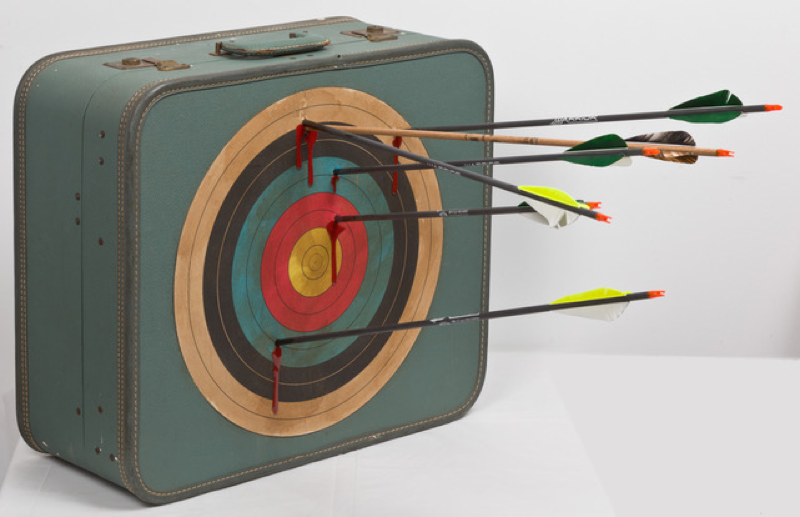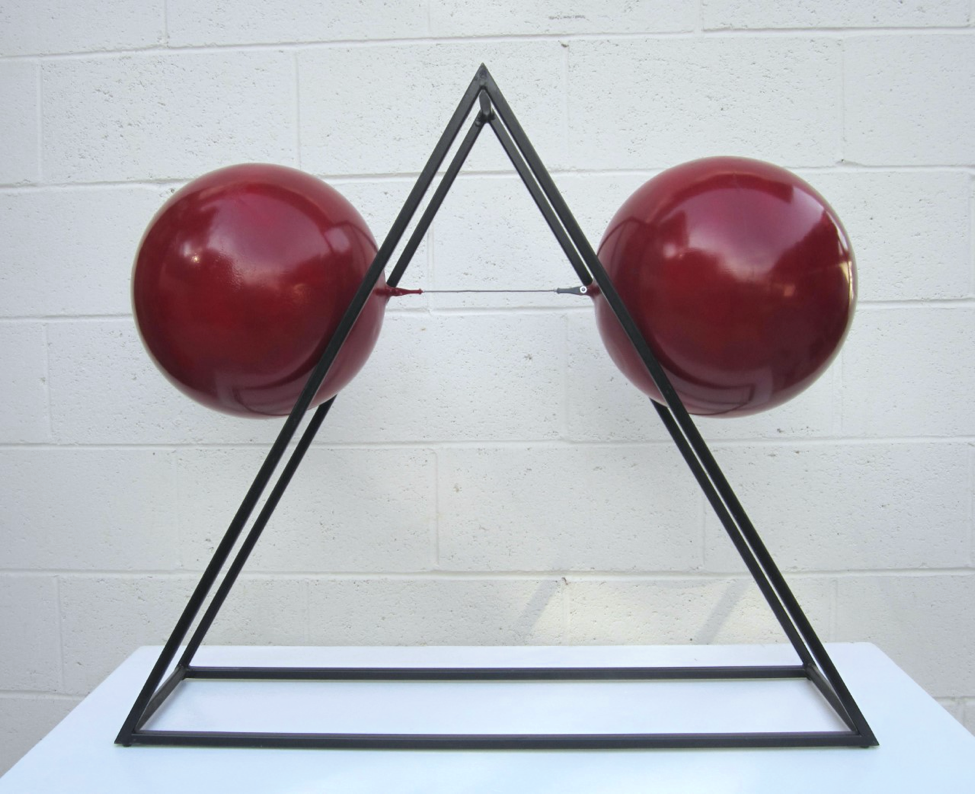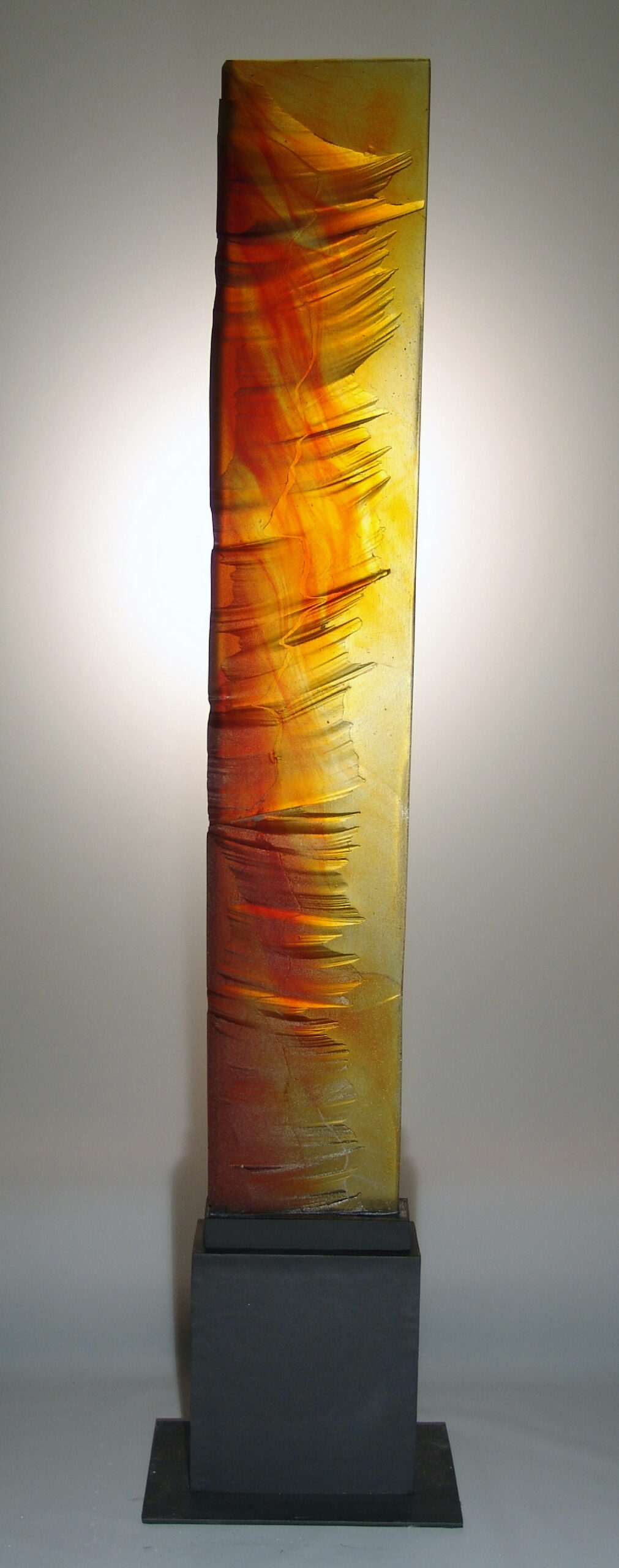Tension
Form
October 7 – November 18, 2023
Bob
Privitt
Biography
Bob Privitt, Master of Fine Arts, Indiana University, taught art at the college and university level for 40 years. Now retired from Pepperdine University after 25 years, he served there most recently as Artist-in-Residence. Privitt’s works have been chosen by jury for inclusion in over 100 national and regional exhibitions and received awards in over one-third of them. He is the recipient of many national, regional and private grants, and was sponsored by the Borchard Foundation in Woodland Hills, CA, to be Scholar-in-Residence at Brittany, France, for six months in 1988–89. A former motorcycle racer, Privitt also once worked as a journeyman ironworker and welder in the construction trade and also helped to build the west spillway of the Glen Canyon Dam in Page, Arizona and also the Atlas Missile Base at Roswell, New Mexico.
Statement
I’m interested in the juxtaposition of disparate elements to create new meaning. I have long been intrigued by images and shapes which seem to have simple and obvious meanings, but upon further examination prove to have multiple and even contradictory meanings. Utilizing some of the conceptual methods of Dada and Surrealism I have tried to examine the psychological balance between that which is “reasonable” and that which is “irrational.” I do not consider myself a Dada or Surrealist artist. I am merely an observer of “THE HUMAN CONDITION” with its myths, dreams, future hopes, flights to freedom, and the balance between positive events and negative actions.
Susan
Amorde

Wounded Baggage I
Biography
Susan Amorde is a Los Angeles-based sculptor and artist who also paints, draws, creates mixed media collages and more. She delights in combining materials and media in new ways, such as bronze, found objects and vintage suitcases. Her background is in figure sculpture and she almost always works with live models. Susan finds inspirations from strong women and champions environmental awareness and social justice. Her artistic influences include Malvina Hoffman, Lucien Freud, Artemisia Gentileschi, Frida Kahlo and Kathy Kollwitz. Furthering influencing her studio practice and professional worldview were her employment at the Getty Museum and Trust, The Frederick Weisman Company and with Artist Ed Ruscha.
She has been exhibiting her works in local and national exhibitions since 2000 at such venues as Torrance Art Museum, Torrance, CA; San Luis Obispo Museum of Art, San Luis Obispo, CA; The Commonwealth Club, San Francisco, CA; Mesa College, San Diego, CA; and Pink Dog Gallery, Ashville, NC.
Susan has a BFA from Long Beach State University, Long Beach, CA.
Statement
Vintage luggage, sourced from flea markets, thrift stores and garage sales, forms the foundation of the “Baggage Series”. These sculptures use mixed media to explore the notion of baggage—in all its emotional and physical manifestations. The works are imbued with a sense of nostalgia and evoke the sense of looking into the souls of the past and present. I examine psychological and social issues while inviting the viewer to imagine their contents, past histories and journeys.
When I happen upon a suitable suitcase, I know it instantly—something about its character and my imagining of its history immediately resonates. I choose specific vintage items for their personalities and for the narrative potential I can weave into my art. I am meticulous about my materials and carefully consider all aspects of the elements that comprise my artworks. Materials are chosen for their visual, historical and conceptual significance. Nothing is left to chance.
My suitcase pieces range in size; some are shown as individual works while others are combined to become large-scale sculptures and installations. In some of my smaller pieces I insert antique brass portholes into the sides of the suitcases with water tanks inside. The portholes function as windows into private, womb-like worlds that are filled with small objects and carefully lit from within. The vignettes I create in these water-filled spaces evoke a sense of discovery as if the viewer has happened upon sunken treasure in the form of specific messages about contemporary issues that should we disregard, we will lose to the depths of history. In the larger pieces, the cases are grouped, piled, stacked or even tied and anchored according to the underlying concept. Some are carefully held for safekeeping, others lost, discarded or abandoned, while others are tied and firmly anchored, unable to complete their journeys. They transform personal narrative into something universal. The pieces become testimonials to the hardships and joys of life’s journey.
Anne
Bedrick

Standing Tall series
Biography
Anne Bedrick transplanted herself from New York to Palm Springs, CA in the spring of 2019. She immediately immersed herself in the vibrant local art scene: opening a gallery-fronted studio space, organizing an art walk for her local studio area as well as founding and organizing the Desert Open Studios tour in the Coachella Valley, with over 150 artists opening their studios to the public.
A self-taught painter, Bedrick creates complex abstract, often large-scale, compositions that are full of color. Her work is often compared to jazz music and evokes different emotional responses from viewers each time that they encounter them. She has had both solo and group exhibitions at a variety of venues across the country and her work is collected internationally.
Statement
I strive to create art that connects us. My complex canvases draw you in and demand your attention. As you listen with your eyes and explore the rich and varied surfaces, the paintings invite you to feel the depth of your own experiences. My paintings are at once a respite from your life and a challenge to it, asking you to be fully awake and aware, to see what is in front of you and to engage with it. I ask no less of myself as I create them.
Each day of painting is a journey of discovery. At times I am fearless, risking losing the beautiful marks and color passages that occurred early on, going past the safe solution I know how to do, to allow the painting to take on the richness of a more surprising conclusion. Each layer and mark reflect the emotions of the moment in which they were created. As the layers build, the lower, hidden ones, inform the visible, in the same way that childhood shapes the adults we become.
This installation, Standing Tall, Consists of 16 Panels – each 24″ x 102″ and 16 Tiles – each 1” x 1”. It plays with scale and with what it means to me to be female today and over the past half century.
50 years ago, at around 7 years old, I began to notice that being female in the world offered a different experience than that offered to my male counterparts.
The nearly 9-foot panels represent women today. They engulf you. Their size demands your attention, they won’t let you ignore them as they claim their space. Loose, unstretched, unbound and standing tall, they step away from “should” and “supposed to”.
By contrast, the 1-inch pieces represent the way that I and many women, learned to be pleasant, helpful, and non- threatening. They fit easily anywhere, are small and won’t take over, you can equally easily choose to look at or walk past them.
Stephen Dee
Edwards
Biography
Stephen Dee Edwards (1954- ) was born in Santa Monica, California. He is a glass artist who strongly believes that, as an artist, he must remain both vital and creative. In 1976 he studied at the Pilchuck Glass Center in Virginia, where he stayed until 1977. From 1976 until 1980, Edwards took courses at the Penland School of Crafts. He earned a B.A. from San Jose State University in California in 1978, and an M.F.A. from Illinois State University in 1980. Edwards has taught at various institutions from the Penland School of Crafts to the University of Kansas. Edwards is a Professor of Glass at Alfred University and the Chair of Three Dimensional Studies. In 1991 he was the President of the Glass Art Society’s Board of Directors. He has received two fellowships from the National Endowment for the Arts. His work is in the permanent collections of the Hokkaido Museum of Modern Art (Japan), the Cevider Museum (Valencia, Spain), the Kestner Museum (Hanover, Germany), and the Oberglas Museum (Bamback, Austria).
Statement
My sculptures have evolved over the past 50 years yet they still represent my ongoing fascination with nature and our relationship to it. Abstract forms are often used to promote meditation on nature, structure and material.
I use glass as it magnifies and sometimes distorts images transforming them into a dreamlike state. I have always been fascinated with the colors and textures found in tide pools and gardens. Through the years I have attempted to convey my love of natural forms, textures and colors through my glass sculptures.
For the last 25 years I have been casting glass. While a professor at Alfred University I made large open-faced molds. We ladled hot glass directly from the 2300 degree glass furnace into rigid sand molds. The resulting castings were then annealed slowly to relieve any strain in the glass. The sculptures were finished by a grinding and polishing process using wet diamond impregnated pads. All the steel work was done in house, customized for each piece. Each sculpture is one of a kind.
My most recent sculptures in glass and metal investigate place, material, color and light. I now use the lost wax process to cast three-dimensional, hybrid forms. The initial form is sculpted in wax and invested in a plaster silica mold. The wax is steamed out and glass is melted into the mold at 1600 degrees. Grinding and polishing finish the work.
We live in a world of forms and colors. Just stop and look. The crack in the pavement, the morning light and a glass of water all contain little miracles of color and light. I try to animate my sculptures with the color and light. A particular color can remind you of a place you have been or the way you feel. Glass conveys the feeling of fragility. Light and color give life to the work.






